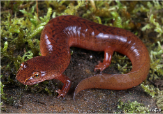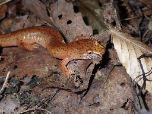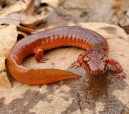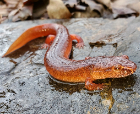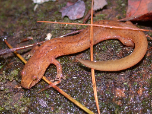Carolina Spring Salamander (Gyrinophilus porphyriticus dunni)
Description: This subspecies can be 5 to 7.5 inches. Adults reach larger sizes at higher elevations as a consequence of delay in development to maturity after metamorphosis in high-level populations. The white line from eye to nostril, bordered below by a conspicuous black or dark brown line, is distinctive. There also may be a dark line above the white line, often conspicuous. The dorsal coloration can be clear reddish, salmon, or orange-yellow marked with black or brown spots or flecks. 17 to 19 costal grooves. Larvae are aquatic and have stream-type morphology. Juveniles are typically more brightly colored than adults.
Habitat: This species is found in cool springs and mountain springs, but is also likely to be found in any wet depression beneath logs, stones, or leaves in the surrounding forest. They require being in areas that provide them with adequate oxygen and moisture because they conduct cutaneous respiration. During the colder months of the year, the salamanders will spend their time in wet soil close to a source of water where they remain somewhat active in burrows, or in the leaf litter near a stream or other body of water.
Range: Distributed through the southern portion of the Blue Ridge Province and the Piedmont from southwest North Carolina to eastern to central Alabama.
Found in these States:
AL |
GA |
NC |
SC
Diet: Although spring salamanders in northern populations feed primarily on invertebrates, spring salamanders in North Carolina are known to consume large numbers of other salamanders. Large spring salamanders will even cannibalize smaller spring salamanders.
Reproduction: Spring Salamanders commonly breed in late summer into fall. The courtship begins with the male sliding his head over the female's body. From there, a tail-straddle walk begins. This walk entails the female straddling the male's tail while both walk forward. From there, the male deposits the spermatophore on the substrate. The female then picks it up and will store it until ready to fertilize eggs. Once the spermatophore is deposited, the male walks forward with his tail standing straight up. He then proceeds to undulate his tail while the base of the tail touches the chin of the female. This causes the tail's base to rub over most of the female's chin.
The females will lay eggs in the summer following their mating. The eggs are sticky when laid and will allow the egg mass to adhere wherever applied. The egg mass can contain between 16 to 160 eggs. The females will protect this egg mass until they hatch, usually in late summer or early fall. The larvae may stay around the mother after hatching but do not directly depend on her. Larvae for this species remain in this larval stage for multiple years, some up to four years. It takes the post-metamorphosis individual another four years before reaching sexual maturity.
Status: Listed as Least Concern in view of its wide distribution and number of subpopulations, presumed large population size, and remaining suitable habitat across its range.
»» Kingdom: Animalia - Animals
»» Phylum: Chordata - Chordates
»» Subphylum: Vertebrata - Vertebrates
»» Class: Amphibia - (Amphibians)
»» Order: Caudata - Salamanders
»» Family: Plethodontidae - Lungless Salamanders
»» Genus: Gyrinophilus
»» Species: Gyrinophilus porphyriticus - Spring Salamanders
»» Subspecies: Gyrinophilus porphyriticus dunni - Carolina Spring Salamander
This article uses material from the Wikipedia article "Spring Salamanders", which is released under the Creative Commons Attribution-Share-Alike License 3.0. Content may have been omitted from the original, but no content has been changed or extended.
|





